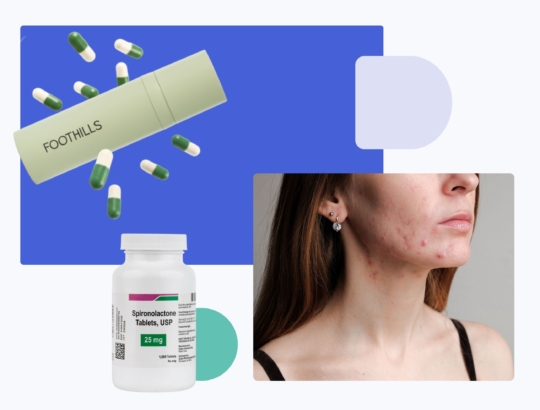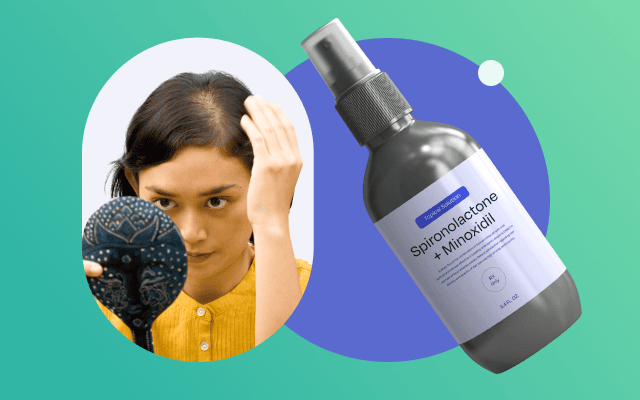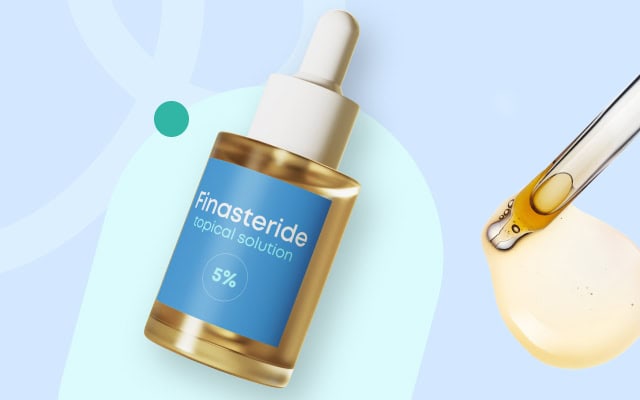Can spironolactone cause hair loss?
Dr. Eric Howell, board-certified dermatologist, talks about the off-label use of spironolactone for female hair loss and hirsutism, including the benefits and side effects.
Table of Content:
What is spironolactone? | Can spironolactone cause hair loss? | How does it work for hair loss? | How can spironolactone work for hair loss and hirsutism at the same time? | What is the dose? | How to get a prescription? | Advantages | Disadvantages | FAQs
Our commitment to producing high-quality content:
The information presented in this article is based on scientific research and the professional advice of our Content Medical Reviewers, who are experts in the field of Dermatology. How we write our content →
What is spironolactone?
Spironolactone is a potassium-sparing diuretic used in the treatment of high blood pressure, edema (swelling). In dermatology it is primarily used for:
- Female hair loss1
- Adult acne in women2
- Hirsutism (excessive hair growth in unusual body areas, like the face)3
Can spironolactone cause hair loss?
Oral spironolactone is generally prescribed for hair loss in women rather than causing it. It is a commonly used anti-androgen medication that blocks the effects of male hormones (androgens) like testosterone, which can contribute to hair loss, particularly in conditions like androgenetic alopecia (female pattern hair loss).
However, while spironolactone is intended to help reduce hair loss, some people may experience an initial shedding phase when they begin taking spironolactone, as with many hair loss treatments. This can be due to hair cycling from a resting phase into a growth phase, a temporary phenomenon that usually resolves within a few weeks to months.
How does spironolactone work for female hair loss?
According to Dr. Howell, spironolactone works for female hair loss by reducing the effects of androgens on hair follicles, which can help slow down hair loss and potentially promote hair regrowth Androgens, such as testosterone and dihydrotestosterone (DHT), may shrink hair follicles and shorten the hair growth cycle, contributing to hair loss4.
Can I experience loss of facial hair and hair growth (in the scalp) while taking spironolactone?
Dr. Howell says that this dual effect can happen because spironolactone blocks androgen activity, which manifest differently on the scalp versus the face. On the scalp, excess androgens may cause thinning of the hair follicles and result in hair loss, so reducing androgenic activity can slow or improve hair loss there. At the same time, lower androgen levels can diminish hair growth in areas prone to hirsutism (such as the upper lip or chin), potentially leading to a noticeable reduction in facial hair. However, individual responses vary, and not everyone will experience both effects to the same degree.
What is the recommended spironolactone dose for hair loss?
Dr. Howell explains that the dosage of spironolactone for hair growth varies depending on individual needs and the evaluation of the prescribing physician. Typically, the starting dose for hair loss is around 50 mg per day, which may be gradually increased to 100 mg to 200 mg daily, depending on the patient’s response and tolerance to the medication.
It’s important to use spironolactone under the guidance of a healthcare provider to monitor for side effects and adjust the dosage as necessary.
What is the recommended spironolactone dose for hirsutism (excessive hair growth)?
Dr. Howell explains that the spironolactone dose for hirsutism is typically the same as when it is prescribed for hair loss, ranging from 50 to 200 mg per day. He also says that many dermatologists start at the lower end (50–100 mg daily) and adjust the dosage based on how well the patient tolerates the medication and how effectively it reduces excessive hair growth.
How long does it take for spironolactone to work for hair loss?
According to Dr. Howell, the time frame for spironolactone to produce visible results in hair growth can vary, but it typically requires several months. Most patients begin to notice a decrease in hair shedding and the first signs of regrowth after 3 to 6 months of regular use. The best results are usually achieved after 6 to 12 months.
Can I get spironolactone over the counter?
Unfortunately not, oral and topical spironolactone are used for hair loss off-label and they are prescription medications, which means you need to have a consultation with a dermatologist in order to get a prescription.
How can you get a spironolactone prescription for hair growth?
You can obtain a prescription for spironolactone through a board-certified dermatologist via Miiskin. The cost for a photo consultation is $59, and the prescription renewal fee is $39.
Benefits of using spironolactone for female hair loss
Using spironolactone for hair loss, offers several benefits:
- Promotion of hair regrowth: Some users experience regrowth as the medication allows hair follicles to recover from androgenic damage.
- Improvement in hair density: With less shedding and possible regrowth, many users see an improvement in overall hair density and thickness.
- Reduction in hair shedding: Spironolactone works by blocking the effects of androgens on hair follicles, which helps to reduce hair shedding.
- Affordable treatment: As an oral medication, spironolactone offers a non-invasive alternative to hair transplantation and is much more affordable5.
Spironolactone side-effects
As with many medications, spironolactone can cause some side effects. The severity and occurrence of these side effects can vary among individuals. Common side effects include:
- Hyperkalemia (high potassium levels)
- Menstrual irregularities
- Breast tenderness or enlargement
- Nausea, vomiting, diarrhea, stomach cramps
- Fatigue, unusual tiredness, lack of energy
- Dizziness or lightheadedness
- Headaches
- Frequent need to urinate, especially at night6
FAQ about using spironolactone for hair loss
Is it safe to use spironolactone for female hair loss during pregnancy?
Dr. Howell advises against using spironolactone during pregnancy, as it can lead to birth defects and harm the developing fetus. Pregnant women or those planning to conceive should avoid this medication.
Is spironolactone also effective for acne?
Yes, spironolactone is used to treat hormonal acne in women. Its anti-androgen properties help decrease sebum production, which can contribute to acne.
Can you use spironolactone for female hair loss?
Yes, spironolactone is a suitable treatment for women with androgenetic alopecia, which causes hair thinning due to sensitivity to androgens, and women with PCOS, who may experience androgen-related hair loss or hirsutism, can use oral spironolactone.
Who should avoid using oral spironolactone for hair loss?
Men, due to the risk of feminizing side effects, pregnant women, as it can harm a developing fetus, individuals with kidney issues or hyperkalemia, those with Addison’s disease, and people taking potassium supplements should not use spironolactone for hair loss.
Is it necessary to use birth control while taking spironolactone?
Dr. Howell often prescribes a birth control method for women on spironolactone to prevent pregnancy, as the medication can cause birth defects.
Can topical spironolactone also be used for female hair loss?
Dr. Howell notes that topical spironolactone is sometimes used off-label for hair growth in women, particularly for androgenetic alopecia. It’s important to consult with a healthcare provider before using it.
Is it possible to combine topical minoxidil and spironolactone for female hair loss?
Yes, combining topical spironolactone for hair loss with minoxidil can be effective for treating female hair loss, especially in cases of androgenetic alopecia, as they work through different mechanisms.
Can topical spironolactone and finasteride be used together for female hair loss?
According to Dr. Howell, combining topical spironolactone with topical finasteride is uncommon. Instead, he suggests topical finasteride + minoxidil for men and topical spironolactone + minoxidil for women.
This article is also available in Spanish: Espironolactona ¿Para que sirve en las mujeres?
Key takeaways
- Purpose in dermatology: Spironolactone is primarily used in dermatology to treat female hair loss, hormonal acne, and hirsutism in women.
- Mechanism of action: Spironolactone works by blocking androgen receptors and inhibiting their production, which helps reduce hair loss by minimizing the impact of androgens on hair follicles.
- Benefits for hair: This medication can reduce hair loss, promote hair growth, improve hair density, and additionally help improve acne in women with hormonal imbalances.
- Side effects: Side effects may include hyperkalemia (high potassium levels), menstrual irregularities, breast tenderness, nausea, fatigue, dizziness, headaches, and frequent urination.
- Pregnancy precautions: Spironolactone should not be used during pregnancy as it can cause birth defects and harm the developing fetus. Women who are pregnant or planning to become pregnant should avoid using spironolactone.
Do you suffer from hair loss problems? Consult an affordable board-certified dermatologist!
Article References:
https://www.ncbi.nlm.nih.gov/pmc/articles/PMC10010138/
https://pubmed.ncbi.nlm.nih.gov/37192767/
https://jamanetwork.com/journals/jama/article-abstract/368969
https://www.jaad.org/article/S0190-9622%2815%2901878-2/fulltext?_ga=2.37363941.470787455.1721634186-1802352099.1721634186
https://www.mayoclinic.org/drugs-supplements/spironolactone-oral-route/side-effects/drg-20071534
Hair loss articles
Reviewed by dermatologists
Using oral minoxidil at a low dose for hair loss
Is alopecia genetic or hereditary?
How to stop alopecia areata from spreading?
Does creatine cause hair loss?
Which vitamin deficiency ACTUALLY causes hair loss?
Can I use a derma roller with minoxidil for enhanced hair growth?







 Request a topical finasteride prescription for hair growth!
Request a topical finasteride prescription for hair growth!